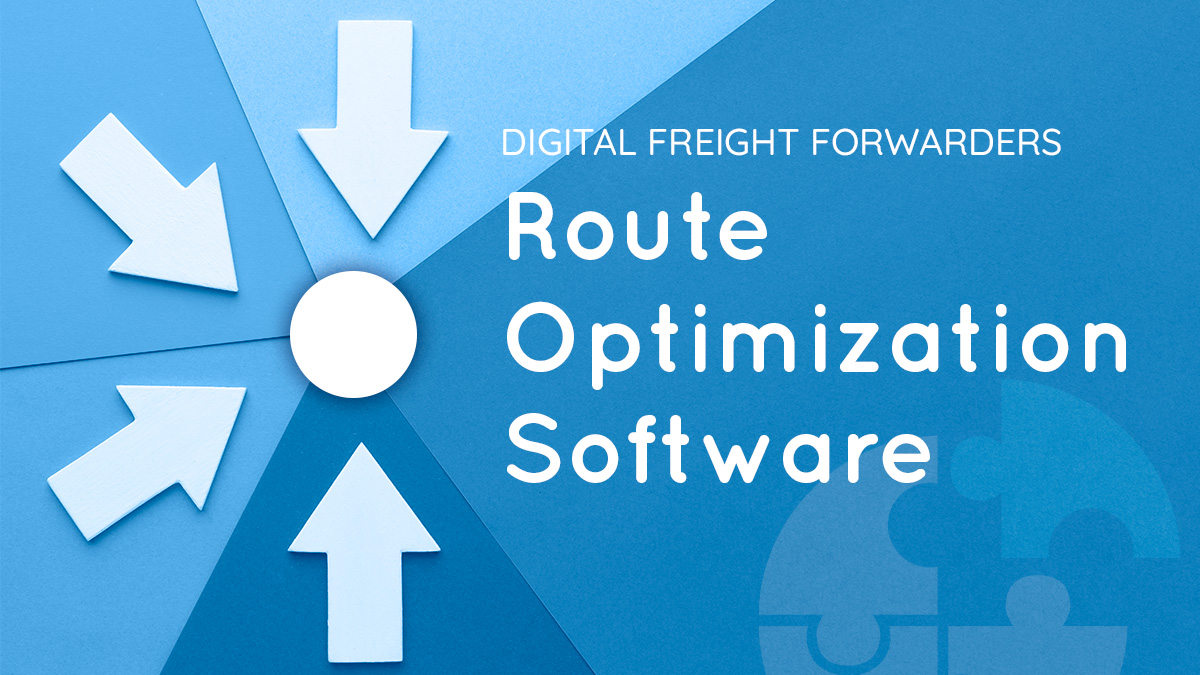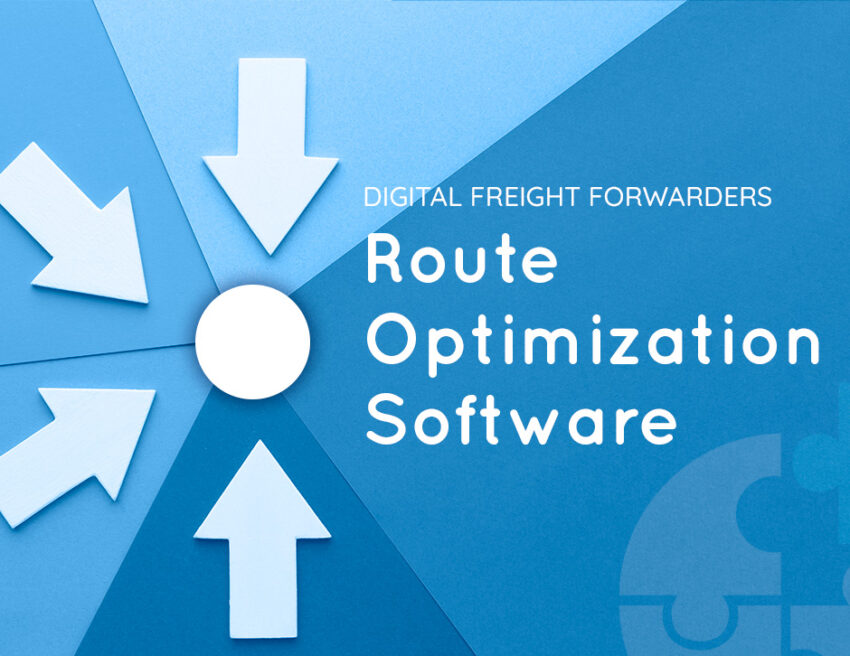Digitalization has become the driving force revolutionizing the shipping and freight industry, ushering in a new era of efficiency and safety for cargo and cargo handlers alike. Despite the strides made in adopting technology to enhance operations, there is still room for improvement in the transportation of logistics industry and substantial number of freight forwarders are already embracing the latest technological trends to complete their transformation into digital freight forwarders. In this blog, we delve into the myriad benefits of the digitalization of logistics, shedding light on how the use of route planning software can unlock a realm of possibilities for all stakeholders involved.

How route planning software can lead to the emergence of digital freight forwarders
Effective route optimization is essential for the freight forwarding sector, particularly for companies engaged in e-commerce and trucking. Freight forwarders dealing with high-priority and intricate delivery needs can greatly benefit from employing route planning systems. In addition to ensuring swift deliveries, these systems help forwarders minimize driver stress, enhance safety, reduce accident risks, mitigate delays, and optimize resource utilization. When planning routes, the system considers various factors including time frames, vehicle capacity, fleet size, weather conditions, historical traffic data, and more. Implementing online route planning systems not only boosts productivity but also ensures customer satisfaction.
Route planning involves determining the most efficient and sustainable route for drivers or delivery associates to complete deliveries. Modern route planning software leverages artificial intelligence and machine learning to optimize delivery routes, ensuring they are as short as possible. This approach helps the logistics operators conserve fuel, reduce delivery times, minimize vehicle wear and tear, and ultimately enhance customer satisfaction thus helping to create a new class of digital freight forwarders.
Advantages of route planning software for the shipping and freight sector
-
On time delivery
Digital freight forwarders can enhance delivery efficiency with route mapping software that identifies the most optimal routes based on factors like distance, traffic conditions, and delivery schedules. By optimizing routes, logistics operations can significantly reduce travel time, fuel consumption, and overall costs. Route optimization systems enable the generation of precise, detailed, and achievable route plans, empowering freight companies to reliably deliver goods within narrow time windows. This consistency leads to improved customer service and a stronger competitive advantage in the market.
-
Cost effectiveness
Route optimization systems can identify the most cost-efficient delivery routes, helping logistics companies reduce fuel expenses by 30% – 40%. Investing in this software can yield significant long-term savings for freight forwarders, especially crucial given the current high fuel costs facing the industry. Moreover, this software reduces fleet travel time, leading to lower truck maintenance costs. By minimizing downtime, trucks can remain in service longer before requiring maintenance.
Moreover, they minimize total distance traveled and allows for real-time adaptation to obstacles like road closures and traffic congestion. Furthermore, AI and Machine Learning (ML) algorithms lower transportation costs by optimizing trip frequency, maximizing vehicle capacity utilization, and reducing overall mileage to mitigate delivery failures.
-
Send constant customer updates
In today’s customer-centric environment, people desire full control over their delivery experience. Customers expect transparency from logistics companies and want to track their shipments in real-time. Route optimization plays a crucial role in meeting these expectations. Leading route optimization systems enable precise assignment of shipments to appropriate resources, providing exact delivery times for informed client communication. Furthermore, these platforms offer dynamic rerouting based on traffic and weather conditions, promptly notifying about potential shipping delays. By leveraging advanced route optimization technology, logistics providers can enhance customer satisfaction through accurate delivery predictions and proactive communication during the shipping process. This ensures a seamless and transparent experience for customers.
-
Enhanced driver and vehicle utilization
AI-driven dynamic route planning software solutions leverage intelligent algorithms to optimize asset and resource utilization effectively. These systems assist managers in matching shipments with appropriate vehicles based on specific criteria, including load type, consignment dimensions, vehicle specifications, geographic location, and local regulations. Logistics managers can streamline deliveries for Full Truck Load (FTL) or Part Truck Load (PTL) shipments, reduce vehicle maintenance costs through improved order consolidation, and minimize delivery expenses by implementing real-time shipment tracking.
-
A must have for e-commerce logistics providers
E-commerce deliveries often require quick turnaround times, making route optimization systems essential. Online shoppers expect rapid delivery, often within 2 days or even on the same day of ordering. Route planning software enables road freight companies to efficiently implement multi-drop route planning within tight timeframes. Furthermore, route optimization software effectively plans numerous deliveries by considering factors such as proximity, time windows, driver productivity, and other critical parameters. This ensures timely and efficient delivery operations to meet the demands of e-commerce customers.
-
Leaves room for contingencies
Route optimization systems enhance your organization’s resilience by enabling rapid responses to unexpected changes. Route planning empowers you to adapt swiftly and identify the most efficient solutions to ensure timely delivery of shipments, all while keeping customers informed throughout the process.
-
Helps to prevent accident
Eliminating inaccurate and uncertain routes can significantly reduce stress and anxiety for drivers. Route optimization systems alleviate stress-inducing obstacles by considering traffic, weather, and road conditions. By minimizing time spent on the road, these systems contribute to enhanced road safety, as stressed and fatigued drivers are less prone to accidents. Many route optimization systems include features to plan routes with minimal turns, which is especially beneficial for nighttime driving, reducing the risk of accidents. Additionally, these software platforms incorporate destination weather forecasts into route planning, proactively addressing weather-related safety concerns to prevent accidents.
-
Greater customer satisfaction
Timely deliveries are paramount for client satisfaction and maintaining a positive reputation in the freight forwarding industry. Utilizing the most efficient routes guarantees prompt and on-time deliveries, providing a competitive advantage and attracting new clients to your business. Ensuring deliveries within tight schedules enhances your company’s credibility and reliability in the eyes of customers and partners alike. By prioritizing efficiency and reliability through route optimization, you establish a strong foundation for long-term success and growth in the logistics sector.
-
Centralized logistics management
Freight forwarders benefit from a holistic view of all logistical components tied to orders, deliveries, and logistics partners through a unified platform. This centralized system provides access to key delivery metrics, including on-time order completions, delivery delays, top-performing riders in terms of timeliness, and other essential performance indicators. Having these insights readily available enables businesses to make informed decisions, optimize operations, and enhance overall efficiency in managing their logistics processes ultimately resulting in the transformation into digital freight forwarders.


